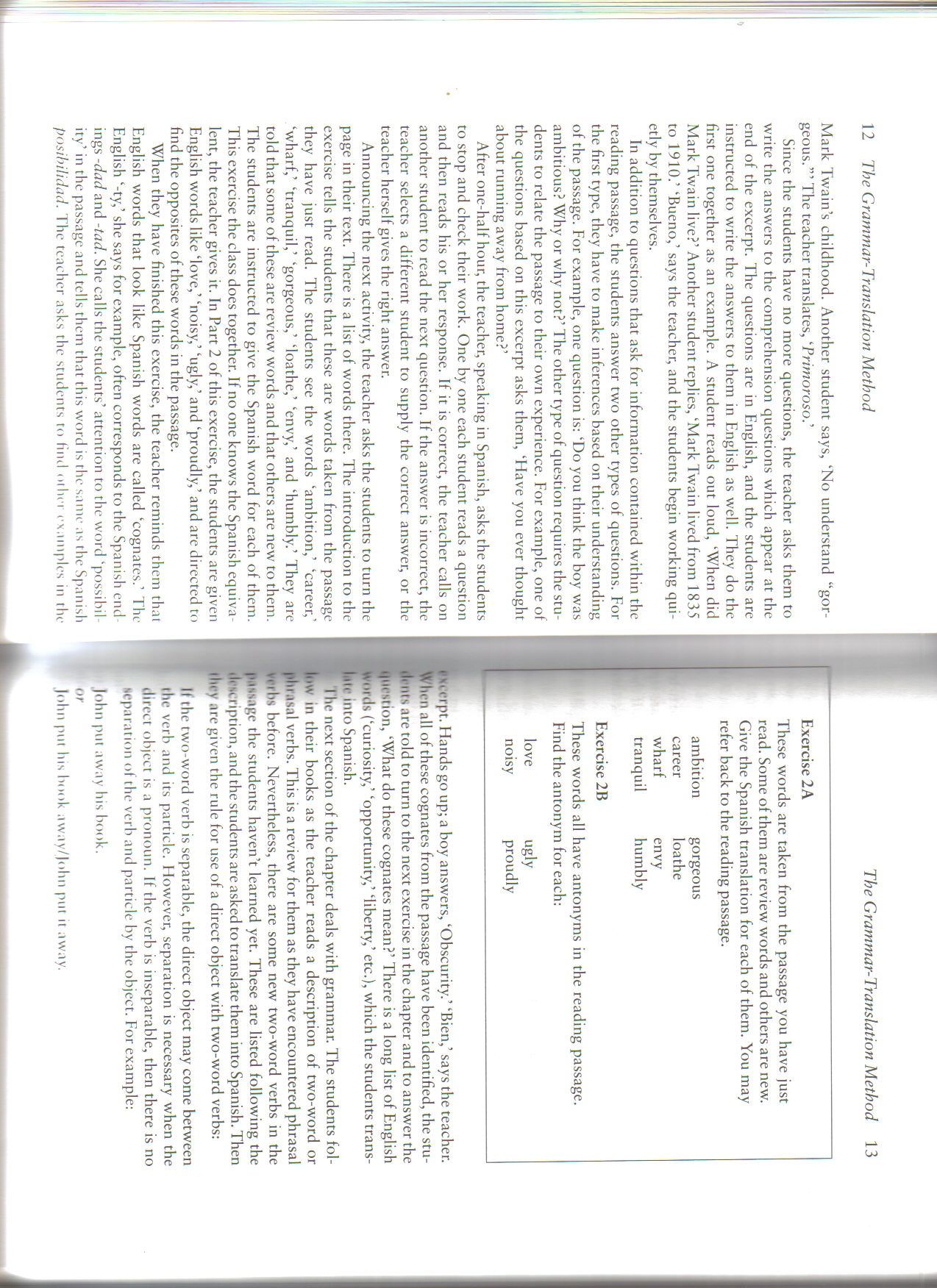2 (368)

12 The Gratnmar-Translation Method
Mark Twain’s childhood. Another student says, ‘No understand “gor-geous.’” The teacher translates, ‘Primoroso.’
Since the students have no morę questions, the teacher asks them to write the answers to the comprehension questions which appear at the end of the excerpt. The questions are in English, and the students are instructed to write the answers to them in English as well. They do the first one together as an example. A student reads out loud, ‘When did Mark Twain live?’ Another student replies, ‘Mark Twain lived from 1835 to 1910.’ ‘Bueno,’ says the teacher, and the students begin working qui-etly by themselves.
In addition to questions that ask for information contained within the reading passage, the students answer two other types of questions. For the first type, they have to make inferences based on their understanding of the passage. For example, one question is: ‘Do you think the boy was ambitious? Why or why not?’ The other type of question requires the students to relate the passage to their own experience. For example, one of the questions based on this excerpt asks them, ‘Have you ever thought about running away from horne?’
After one-half hour, the teacher, speaking in Spanish, asks the students to stop and check their work. One by one each student reads a question and then reads his or her response. If it is correct, the teacher calls on another student to read the next question. If the answer is incorrect, the teacher selects a different student to supply the correct answer, or the teacher herself gives the right answer.
Announcing the next activity, the teacher asks the students to turn the page in their text. There is a list of words there. The introduction to the exercise tells the students that these are words taken from the passage they have just read. The students see the words ‘ambition,’ ‘career,’ ‘wharf,’ ‘tranquil,’ ‘gorgeous,’ ‘loathe,’ ‘envy,’ and ‘humbly.’ They are told that some of these are review words and that others are new to them. The students are instructed to give the Spanish word for each of them. This exercise the class does together. If no one knows the Spanish equiva-lent, the teacher gives it. In Part 2 of this exercise, the students are given English words like ‘love,’ ‘noisy,’ ‘ugly,’ and ‘proudly,’ and are directed to find the opposites of these words in the passage.
When they have finished this exercise, the teacher reminds them that English words that look like Spanish words are called ‘cognates.’ The English ‘-ty,’ she says for example, often corresponds to the Spanish end ings -dad and -tad. She calls the students’ attention to the word ‘possibil ity’ in the passage and tells them that this word is the same as the Spanish posibilidad. The teacher asks the students to fiiul other examples in the
Exercise 2 A
These words are taken from the passage you have just read. Some of them are review words and others are new. Give the Spanish translation for each of them. You may refer back to the reading passage.
ambition gorgeous
career loathe
wharf envy
tranquil humbly
Exercise 2B
These words all have antonyms in the reading passage. Find the antonym for each:
love ugly
noisy proudly
im erpt. Hands go up; a boy answers, ‘Obscurity.’ ‘Bień,’ says the teacher. When all of these cognates from the passage have been identified, the stu-ilentsare told to tum to the next exercise in the chapter and to answer the i|uestion, ‘What do these cognates mean?’ There is a long list of English words (‘curiosity,’ ‘opportunity,’ ‘liberty,’ etc.), which the students trans-I ile into Spanish.
The next section of the chapter deals with grammar. The students fol-low in their books as the teacher reads a description of two-word or |'ln asal verbs. This is a review for them as they have encountered phrasal veibs bcfore. Nevertheless, there are some new two-word verbs in the |M'.sage the students haven’t leamed yet. These are listed following the i li scription, and the students are asked to translate them into Spanish. Then lin y are given the rule for use of a direct object with two-word verbs:
II the two-word verb is separable, the direct object may come between the vcrb and its particie. However, separation is necessary when the direct object is a pronoun. If the verb is inseparable, then there is no separation of the verb and particie by the object. Forexample:
|ohn pui away his book. or
|olm pui los book away/Jolm pul u away.
Wyszukiwarka
Podobne podstrony:
1 (540) The Grammar-Translation MethodINTRODUCTION I he Grammar-Translation Method is not new. It ha
The Gramniar-Translation Method (Classical Method) The grammar-translation method is a method of for
4 (290) 16 The Grammar-Translation MethodObservations 3 The teacher asks students
3 (330) 14 The Grammar-Translation Method but not John put away it. (because ‘put away’ is a separab
Dybiec-Gajer, J. 2013. „The Making of Mark Twain in the Polish Context - On the Author’s lOOth Death
Figurę 12: The components of the KASUMI błock cipher (from [6]). • Encryption key
Ekonomia polityczna jako nauka i jako sztuka (2) John Neville Keynes (ojciec J. M. Keynesa)- The Sco
SAVE0362
więcej podobnych podstron